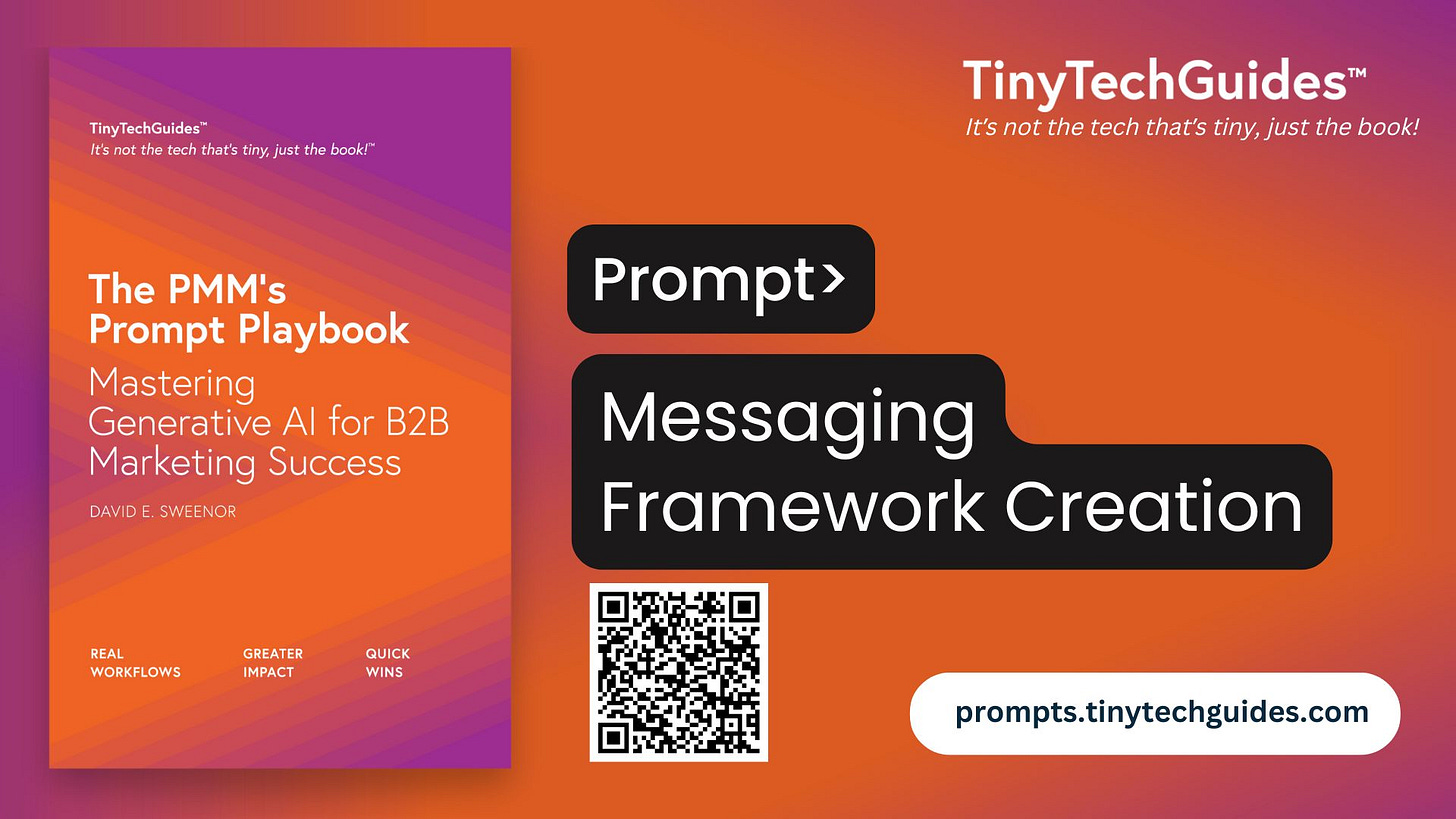Prompt Workflow: Messaging Framework Creation
Positioning and Messaging
This prompt, along with 30 others, is included in The PMM’s Prompt Playbook. These cut-and-paste prompts, along with bonus prompts not in the book, will be made available to paid subscribers on a weekly basis.
What does this do?
The Messaging Framework Creation workflow helps businesses develop a structured and compelling messaging framework that aligns with their target audience, product value, and competitive differentiation. By defining key messages, proof points, and audience-specific positioning, this workflow ensures clear, consistent, and impactful communication across marketing, sales, and customer engagement efforts.
Workflow steps
Identify the target audience and their key pain points
Develop a core value proposition that clearly defines how the solution delivers value
Create key messages that articulate benefits and differentiation
Support key messages with proof points such as features, data, and case studies
Align messaging to different audience segments for relevance and personalization
Summarize the final messaging framework for use in sales, marketing, and customer engagement
Define the inputs
{industry=Insert your target industry, e.g., cloud infrastructure for enterprises.}
{solution=Insert your product/solution, e.g., automated cloud cost optimization platform.}
{audience=Insert target audience, e.g., IT operations leaders, CFOs, DevOps engineers.}
{value drivers=Insert key value drivers, e.g., cost savings, performance optimization, and workflow automation.}
Define the objective
<role/>
You are a product marketing expert creating a messaging framework for {solution} in the {industry}.
</role>
<context/>
I need to develop a messaging framework that clearly articulates the value of {solution} to {audience}. This framework will support sales, marketing, and customer success efforts by providing consistent, audience-specific messaging that highlights our unique value proposition and key differentiators.
</context>
<task/>
Create a messaging framework for {solution} that includes the following:
**Target audience**: Who are we speaking to (roles, industries, pain points)?
**Core value proposition**: The overarching value delivered by {solution}.
**Key messages**: The top 3–5 messages that convey the value of {solution} to the audience.
**Supporting proof points**: Features, benefits, or data that reinforce each key message.
</task>
<format>
Provide the response in a structured format:
Target audience:
-role: [e.g., IT leaders, CFOs].
-Key Pain Points: [e.g., “Difficulty managing cloud costs,” “Lack of visibility into infrastructure performance”].
Core value proposition:
-“[Solution] helps [audience] achieve [outcome] by [key differentiator].”
Key messages and proof points:
Key Message
Supporting Proof Points
[Message 1: Key value communicated]
[Feature or benefit 1]
[Message 2: Key value communicated]
[Feature or benefit 2]
[Message 3: Key value communicated]
[Feature or benefit 3]
</format>
<tone>
Clear, concise, and customer-focused.
</tone>
Identify the target audience and pain points
<role/>
You are a customer research specialist defining the target audience and their key challenges for {solution}.
</role>
<context/>
To ensure our messaging resonates, I need to clearly identify the primary audience and their most pressing pain points. Focus on the specific roles, industries, and challenges they face that {solution} can address.
</context>
<task/>
Answer the following:
-Who is the **primary target audience** for {solution}? Include details like role, company size, and industry.
-What are their **top 3 pain points** that {solution} can solve?
-How do these pain points impact their business or workflows?
</task>
<format>
Provide the response in bullet points:
-Target audience:
o Role: [Primary roles/titles].
o Company size: [SMB, mid-market, enterprise].
o Industry: [Industry specifics].
-Top pain points:
o Pain Point 1: [Brief description of the challenge].
o Pain Point 2: [Brief description of the challenge].
o Pain Point 3: [Brief description of the challenge].
-Impact:
o [How the pain points affect business outcomes or workflows].
</format>
<tone>
Audience-focused, empathetic, and problem-driven.
</tone>



